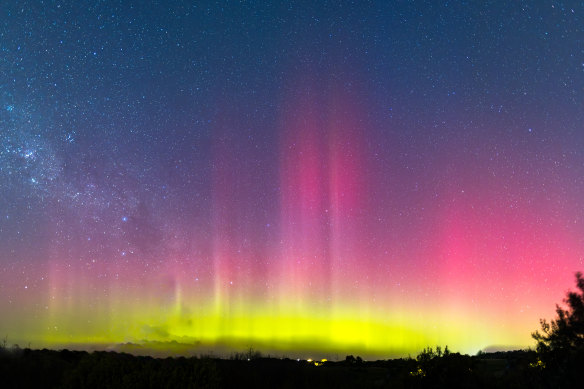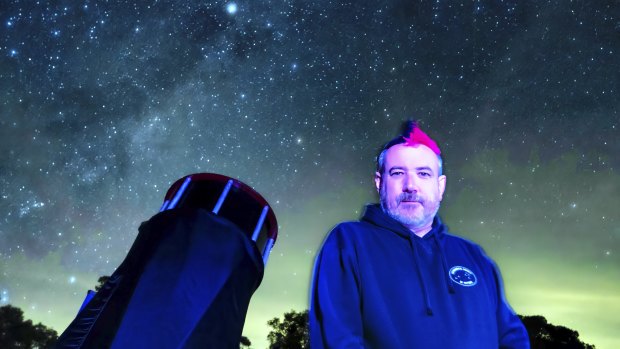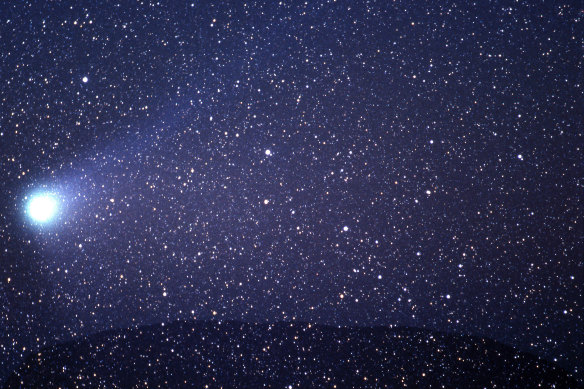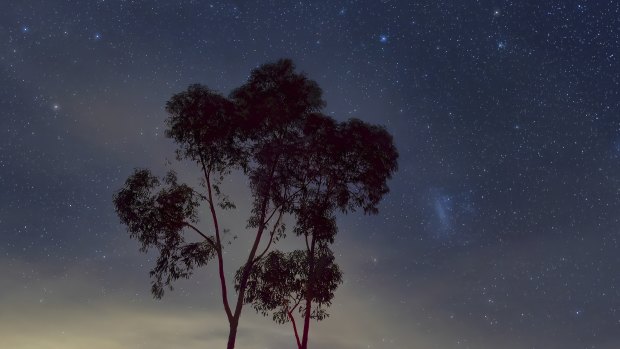This was published 8 months ago
Why Victorians should keep looking to the night sky to be dazzled
The stunning aurora australis light display might have dimmed, but astronomy lovers have sky-high hopes for the next celestial event that promises to dazzle stargazers.
Astronomers say while there is a chance of another aurora show next week, excitement is building for the arrival of a comet that may be visible to the naked eye later this year.

A view of the aurora australis at Fingal on the Mornington Peninsula. Credit: Getty
Monash University astronomy associate professor Michael Brown said because the sun is almost at its solar maximum there might be some more glimpses of aurora lights, particularly in dark country skies away from other sources of light.
“You might see something quite beautiful,” he said.
Brown said the sun spots that created the recent aurora light show were rotating back into alignment, which meant there could be more aurora opportunities next week.
Brown said a moonless sky presented the best opportunities to catch another glimpse of aurora lights, but it would probably be less spectacular than the recent show.
Astronomers are also hoping for a bright display when a comet, known as Tsuchinshan-ATLAS, arrives in our night sky in late September or early October. Brown said the comet was showing much promise early.
“It may be a brilliant comet … They can be amazing, but they have a reputation for not living up to early expectations.”
The National Aeronautics and Space Administration (NASA) describes comets as large objects made of dust and ice that orbit the sun and are best known for their streaming tails.
But budding astronomers need not spend big money to start out stargazing. Astronomical Society of Victoria president Mark Iscaro described some telescopes as “hobby killers” that make grand magnification promises, but are tricky to use.

Astronomical Society of Victoria president Mark Iscaro.Credit: Luis Enrique Ascui
He said these devices can be difficult to position and manoeuvre, making it challenging to locate objects in space.
Iscaro said cold, clear and still nights were often best for stargazing, particularly in country areas where stars appear brighter.
“I love how cathartic it is,” he said. “It’s peaceful and relaxing.”
The society operates nine visual telescopes that observers can use from a site near Heathcote in central Victoria. The largest is a 40-inch telescope that can see galaxies up to 80 million light-years away.

Observatory domes at the Astronomical Society of Victoria’s dark sky site near Heathcote. Credit: Luis Enrique Ascui
But Iscaro insisted it is still possible to get a great view of the stars from suburban Melbourne on a cloudless night.
Astronomical Society of Victoria demonstrator Bill Stent recommends starting out with a humble pair of binoculars with a magnification factor of seven and aperture of 50 rather than a telescope.
He said while the Tsuchinshan-ATLAS comet may be visible to the naked eye later this year, binoculars are ideal for comet viewing because they typically provide a wider view than a telescope and draw in more light than human eyes. But Stent also warned comets could be fickle.
“Comets can be underwhelming, but a really good one is something you do remember.”

Halley’s Comet over Uluru in 1986. Credit: Getty
He expected the comet may be visible when it gets closest to the sun on September 28 and its tail may begin to brighten.
Stent said in early October the best chance to catch a glimpse of Tsuchinshan-ATLAS would be just before dawn slightly above the eastern horizon. Then later in October, he said, the comet may come into view just after dusk above the western horizon.
He suggested downloading an app such as SkyView, Stellarium or Sky Safari that identify and map stars and planets.
Currently, the Scorpius constellation is particularly bright in the eastern skies. Stent said it is possible to see the shape of the scorpion’s tail, which looks like a large reversed question mark.
Astronomers generally agree a moonless night is best for viewing stars.
For gazing at the moon itself, however, Stent said a half moon is ideal because the shadows help to define the landscapes including valleys and craters.
For the moment, Ballarat Observatory manager Judith Bailey has her eye on the star Eta Carinae, which is considered unstable and may become a supernova, meaning it could erupt in an explosion.
“It’s possible it could go supernova any tick of the clock or in a thousand years,” she said.

The night sky at Lady’s Pass near Heathcote.Credit: Luis Enrique Ascui
Bailey said supernovas can make for dramatic viewing. “They’re not visible to the naked eye very often,” she said. “The last one I saw was in 1987, and it was very bright.”
Get to the heart of what’s happening with climate change and the environment. Our fortnightly Environment newsletter brings you the news, the issues and the solutions. Sign up here.